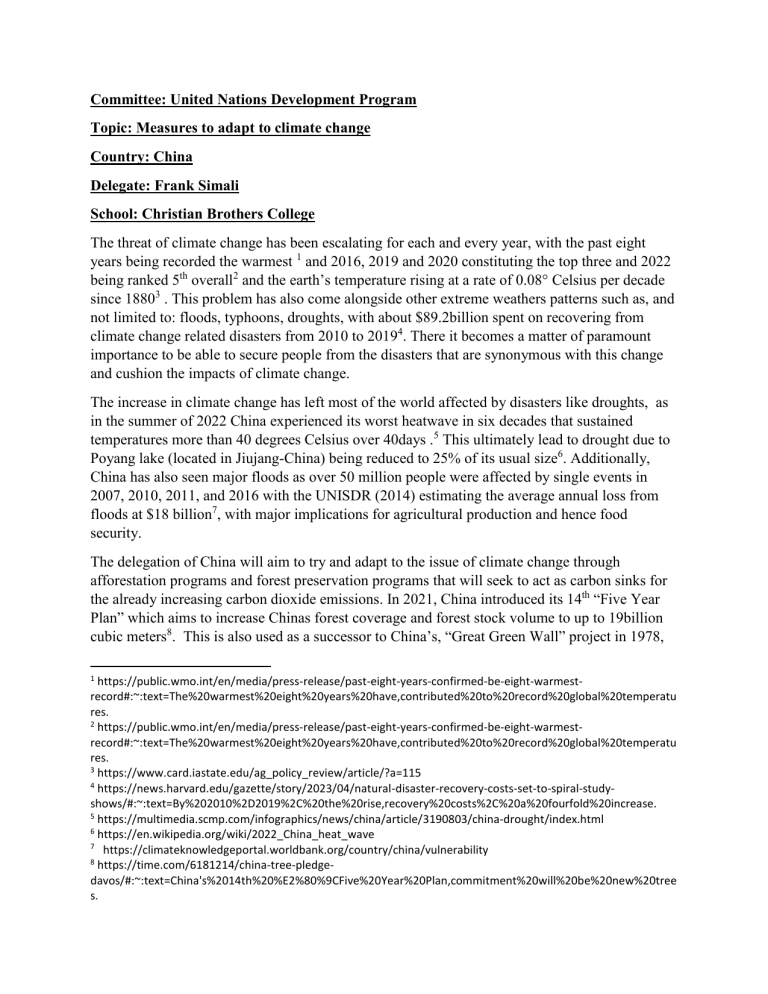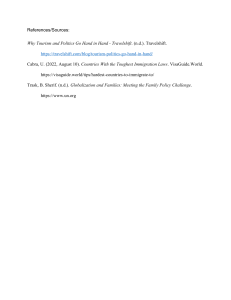
Committee: United Nations Development Program Topic: Measures to adapt to climate change Country: China Delegate: Frank Simali School: Christian Brothers College The threat of climate change has been escalating for each and every year, with the past eight years being recorded the warmest 1 and 2016, 2019 and 2020 constituting the top three and 2022 being ranked 5th overall2 and the earth’s temperature rising at a rate of 0.08° Celsius per decade since 18803 . This problem has also come alongside other extreme weathers patterns such as, and not limited to: floods, typhoons, droughts, with about $89.2billion spent on recovering from climate change related disasters from 2010 to 20194. There it becomes a matter of paramount importance to be able to secure people from the disasters that are synonymous with this change and cushion the impacts of climate change. The increase in climate change has left most of the world affected by disasters like droughts, as in the summer of 2022 China experienced its worst heatwave in six decades that sustained temperatures more than 40 degrees Celsius over 40days .5 This ultimately lead to drought due to Poyang lake (located in Jiujang-China) being reduced to 25% of its usual size6. Additionally, China has also seen major floods as over 50 million people were affected by single events in 2007, 2010, 2011, and 2016 with the UNISDR (2014) estimating the average annual loss from floods at $18 billion7, with major implications for agricultural production and hence food security. The delegation of China will aim to try and adapt to the issue of climate change through afforestation programs and forest preservation programs that will seek to act as carbon sinks for the already increasing carbon dioxide emissions. In 2021, China introduced its 14th “Five Year Plan” which aims to increase Chinas forest coverage and forest stock volume to up to 19billion cubic meters8. This is also used as a successor to China’s, “Great Green Wall” project in 1978, 1 https://public.wmo.int/en/media/press-release/past-eight-years-confirmed-be-eight-warmestrecord#:~:text=The%20warmest%20eight%20years%20have,contributed%20to%20record%20global%20temperatu res. 2 https://public.wmo.int/en/media/press-release/past-eight-years-confirmed-be-eight-warmestrecord#:~:text=The%20warmest%20eight%20years%20have,contributed%20to%20record%20global%20temperatu res. 3 https://www.card.iastate.edu/ag_policy_review/article/?a=115 4 https://news.harvard.edu/gazette/story/2023/04/natural-disaster-recovery-costs-set-to-spiral-studyshows/#:~:text=By%202010%2D2019%2C%20the%20rise,recovery%20costs%2C%20a%20fourfold%20increase. 5 https://multimedia.scmp.com/infographics/news/china/article/3190803/china-drought/index.html 6 https://en.wikipedia.org/wiki/2022_China_heat_wave 7 https://climateknowledgeportal.worldbank.org/country/china/vulnerability 8 https://time.com/6181214/china-tree-pledgedavos/#:~:text=China's%2014th%20%E2%80%9CFive%20Year%20Plan,commitment%20will%20be%20new%20tree s. that combatted the encroaching Gobi desert and also the sand storm plagued city of Beijing’s sand storm frequency fell by one fifth.9 China has faced the continuous risk of the implications of rising sea levels as places like BeijingTianjin-Hebei and the Yangtze River Delta being highly at risk with a combined population of 126 million people10. Building seawalls and other coastal defenses will be needed to try and protect these coastal regions. This is helping to reduce the risk of flooding and coastal regions being heavily affected, and islands being submerged in water. Currently, Shanghai has now been enveloped with 100kilometres of storms walls to do so11 China also sees it as necessary to put all eyes on energy conservation plans and investment of renewable energy sources to equally distribute reliance on fossils and these renewable energy sources. Although, China is one of the largest carbon emitters with it emitting 27% of the worlds carbon dioxide levels12 in 2022 nearly half of the world's low-carbon spending took place in China. It has invested $546 billion on investments that included solar and wind energy, electric vehicles and batteries13. By doing so we reduce the levels of greenhouses gases being emitted in the earth’s atmosphere and less chance of perpetuating the effects of climate change on a global level. The country has also undergone processes in developing new agricultural practices and systems that are more resilient to the effects of climate change such as growing drought tolerant crops. This is to ensure food security for nations, as this will allow for no halt in agricultural production during times of famine. To conclude, there need to be efforts in providing protection to the globes ecosystems and hydro systems, in order to avoid food crisis’ and shortages as climate change develops as well as a means to protect all people’s daily lifestyles from being impacted by climate change. It’d be also best to reduce overreliance on non-renewable sources of energy, by implementing renewable energy sources in the bid to reduce carbon emissions and increasing temperatures. 9 Thousands of acres of shifting dunes have been stabilized while the frequency of the sandstorms that regularly plague Beijing especially fell by one-fifth nationwide between 2009 and 2014. 10 https://www.sixthtone.com/news/1006652 11 https://www.sixthtone.com/news/1006652 12 https://www.worldbank.org/en/news/press-release/2022/10/12/china-s-transition-to-a-low-carbon-economyand-climate-resilience-needs-shifts-in-resources-andtechnologies#:~:text=China%20emits%2027%20percent%20of,energy%20efficiency%20and%20resource%20produ ctivity. 13 https://www.scientificamerican.com/article/china-invests-546-billion-in-clean-energy-far-surpassing-the-us/#:~:text=The%20country%20spent%20%24546%20billion,investments%2C%20which%20totaled%20%24141%20 billion.







